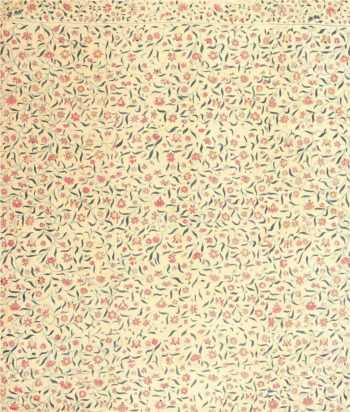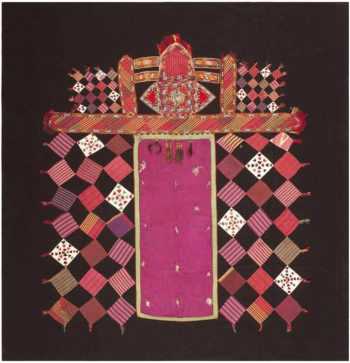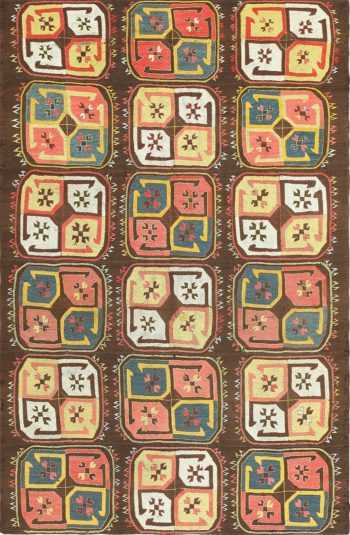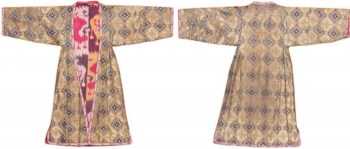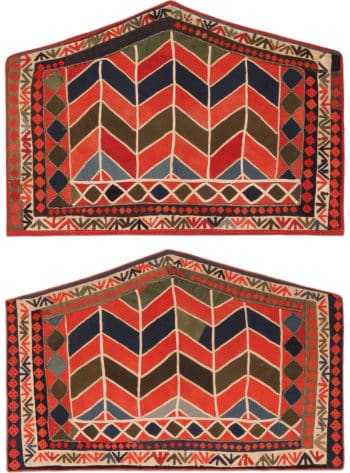Uzbekistan Textiles
View the below selection of beautiful antique Uzbekistan textiles and embroideries:
Large 17th Century Indo-Portuguese Summer Carpet 46159
Size: 13 ft 2 in x 26 ft (4.01 m x 7.92 m)Floral Antique Suzani Embroidered Textile 40551
$8,800.00Size: 6 ft 10 in x 7 ft 10 in (2.08 m x 2.39 m)Silk Antique Uzbek Suzani Embroidery Textile 71837
Size: 6 ft 7 in x 7 ft 9 in (2.01 m x 2.36 m)Antique Uzbekistani Horse Cover Textile 46141
$4,900.00Size: 7 ft x 7 ft 5 in (2.13 m x 2.26 m)Antique Turkman Design Uzbekistan Embroidery Textile 47484
$9,500.00Size: 4 ft x 6 ft (1.22 m x 1.83 m)Antique Silk Uzbek Tree Of Life Design Embroidery 47242
$9,000.00Size: 4 ft x 6 ft (1.22 m x 1.83 m)Silk and Metallic Antique Uzbek Dress 47508
$8,800.00Size: 4 ft 3 in x 5 ft 1 in (1.3 m x 1.55 m)Pair Of Antique Uzbek Karakalpak Textiles 49962
$1,750.00Size: 3 ft 7 in x 2 ft 4 in (1.09 m x 0.71 m)
Uzbekistan Embroidery and Textile: The Fabric That Almost Ceased to Exist
The people of Uzbekistan have etched out their existence in a harsh, sun-dried landscape that lies in central Asia. Theirs is a land of high, arid plains, salt marshes, and caverns. The Aral sea provides some relief to the north. From this environment, the people have developed textile arts and show their unique character and are some of the most beautiful in the world. Let’s explore them these splendid works.
Uzbekistani Textiles and Their Influences
The textiles of Uzbekistan are the culmination of a diverse history that includes many different cultural influences. The first inhabitants of the area were the Scythians, a group of Iranian nomads who occupied the area around eh 8th-6th centuries BC. In the 7th century, the area was part of the Islamic conquest, and much of the population converted to Islam. In the 13th century, the Mongols conquered the area, after which it was ruled by the Turkic people and became part of the Timurid Empire. During the 19th century, it became part of the Russian Empire.
As you can see, the area known as Uzbekistan has a rich cultural history, but you might be wondering what this has to do with their textile arts. You might also be wondering why this area was fought over by so many. These two things are tied together. The area currently known as Uzbekistan lies in the middle of an intersection through which all three main routes of the famed Silk Road passed.
Its location as a hub of the Silk Road allowed Uzbekistan to be exposed to the arts and culture of all that passed through. This inspired the local population to develop a highly sophisticated art and cultural heritage. In their artwork, you can see the influences of Chinese, Persian, Turkish, Mongolian, and Indian culture. Beginning in the 19th century, you also begin to see the Russian influence in the artwork and textiles, too.
Silk Production in Uzbekistan
When you think of silk production, Uzbekistan is not the place that typically comes to mind first. However, its placement on the silk road allowed Uzbekistan to develop a highly lucrative sericulture industry. The availability of local silks led to the creation of textiles that were heavily embroidered with silk threads. These were called suzani, and they also developed another type of fabric called ikat that is made from spun silk. These two textile types make up the most recognizable regional fabrics from the area.
The suzani textiles are heavily embroidered pieces. The word “suzani” in Farsi means embroidery. Each piece of suzani is individual and has a unique story behind the work. The embroidery begins when a daughter is born. The fabric is added to by the family and is meant to adorn the young woman’s marital bed when she is wed. It is a unique gift that is part of her dowry. It is a work that takes years to complete and meant to mark the crowning movement in her life.
Suzani is more than a piece of embroidery. They contain symbolism that is identifiable regionally. They use using traditional motifs that might indicate tribal affiliations, family affiliations, or make special events. Many of these symbols include the pomegranate, which is full of seeds and life. This is to grant the young couple fertility, prosperity, and abundance. Many of the textiles have metallic threads and are created using extremely fine work. Many of suzani use design motifs that include the moon, sun, flowers, leaves, vines, and fruits. The most popular ones are tulips, carnations, and irises. Occasionally, you might see fish and birds, too.
Recently, modern garment makers attempted to replicate traditional suzani patterns by hand. A single garment took over 3,000 hours to embroider. This gives anyone a new appreciation for an authentic suzani when they see one.
Uzbek Ikat Textiles / Cloth
Ikat cloth is the other type of textile associated with Uzbekistan. One of the more interesting points about this textile type is that scholars think that it seemed to emerge simultaneously in different parts of the world.
Many modern fabrics are sold as Ikat, but this is not necessarily accurate. The manufacturers are referring to a similar dye pattern, but it is not traditional ikat and should not be confused. These cotton and cotton blend reproductions might copy the dye pattern, but they can never compare to a real Uzbekistan silk ikat.
Silk has a sheen that cannot be reproduced in synthetics. It has a look and feel that is entirely different from the modern copies. However, these reproductions also indicate the popularity of these beautiful patterns, even among contemporary designers. Ikat reproductions have made their way onto catwalks at fashion shows recently, but they are not the real ikat fabrics from Uzbekistan.
Ikat from Uzbekistan is called abrabandi, which means “bound cloud.” It is created using a resist dye technique that is similar to Japanese shibori dyed fabric. The process involves applying a resist to the warp threads that are bound together with threads and dyed before weaving.
Ikat weaving began in the Fergana Valley in the 12th century. These fabrics were an important part of the culture, and when someone received an award, they were presented with ikat robes to mark the occasion. However, this ended when the Soviet Union took over the area. The weavers were forced to produce standardized patterns and the traditional ikat weaving patterns almost all but died out.
Few Surviving Pieces
When the Soviet regime took over the area, it meant an end to traditional silk textile production that had been a part of the traditional local culture since the 12th century. This means that when you do happen to find an authentic suzani embroidery piece or a real silk ikat textile, they are a rare treasure. These beautiful artworks were intentionally eliminated from existence in an attempt to stomp out traditional culture completely.
However, even though they were officially banned, some traditional weavers continued to produce them in secret. Some of these secret ikat production facilities were located in the Fergana Valley, protected by the harsh landscape that was difficult to traverse and navigate. The landscape might have been challenging, but it allowed the traditional weavers to remain hidden from sight so that they could secretly keep the craft alive. That is why these pieces are exceptionally rare, but there are still a few available.
In one of these factories, in the city of Margilan, a group of artisans kept the tradition of raising silk and keeping the skills alive. They still live at the factory and become masters of their craft. These weavers continued to keep the traditions alive and as of 2010, were still producing the cloth in the traditional way using hand looms.
The colors used for suzani and ikat cloth are all created using natural dyes. Silk can be spun into incredibly fine, durable threads. The fabric produced using this technique is exceptionally lightweight, yet strong. Silk has the ability to take dyes easily, allowing vibrant colors to be created.
The colors are created using cochineal and madder root for reds. Dried pomegranate rind is used for gold. Walnut husk creates browns, and indigo is the traditional material for blues. Nothing beats the beauty of an authentic ikat textile. Many modern reproductions do not use the traditional technique and are printed after the cloth is made. A trained eye can distinguish these from the real Uzbekistan ikat cloth.
There is more than meets the eye behind the fabulous suzani and ikat cloth that we occasionally have the privilege to offer. Each piece is more than a beautiful piece of work. Every one of them is a unique creation of artistry and the expression of a traditional culture that was nearly wiped out. In the case of the suzani carpet, it is the individual artwork of the family and region. It represents a special gift that took years to create. Ikat textiles have over 800 years of tradition behind them.
The occupation of the Soviet Union in Uzbekistan nearly eliminated all of the traditional arts, and we are fortunate to have the few pieces of these textiles that still exist. We encourage you to look around at our collection of suzani and ikat textiles. Perhaps, you will find one that you must-have for your own collection.


